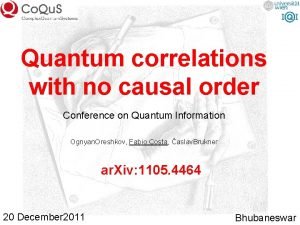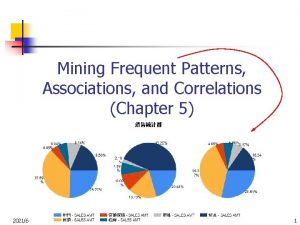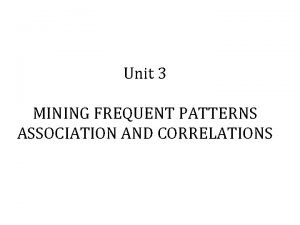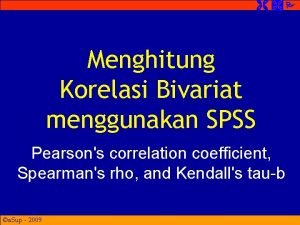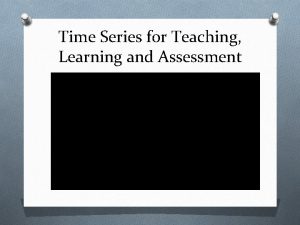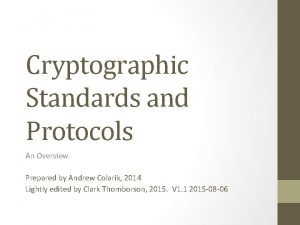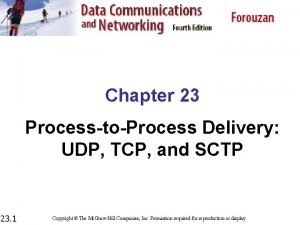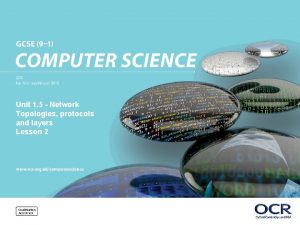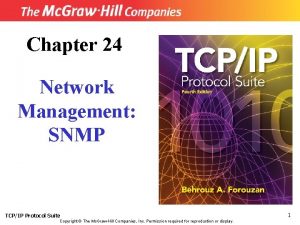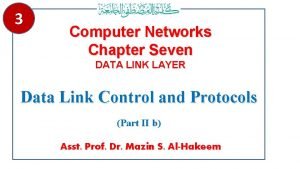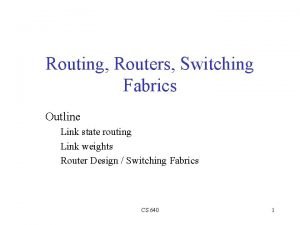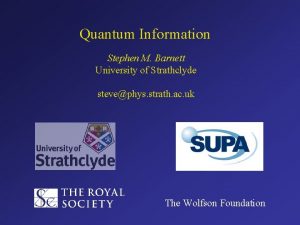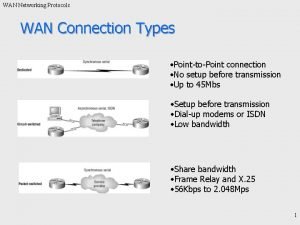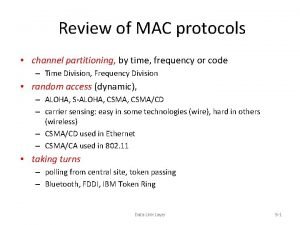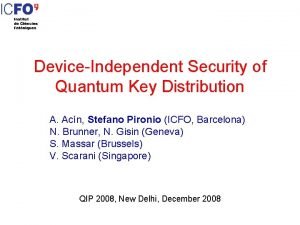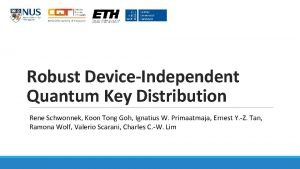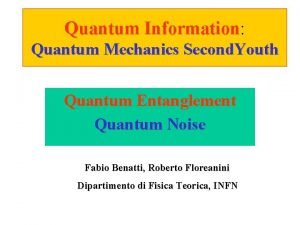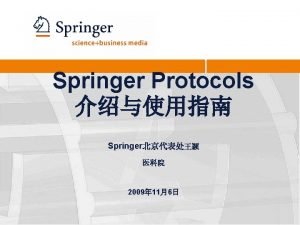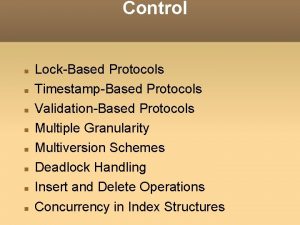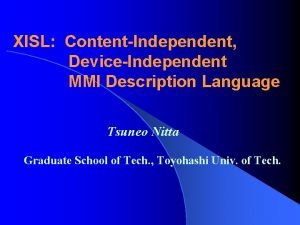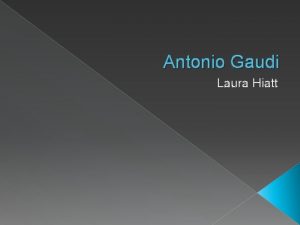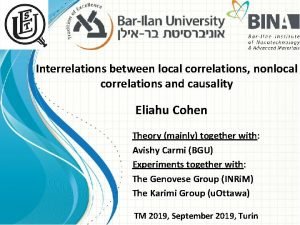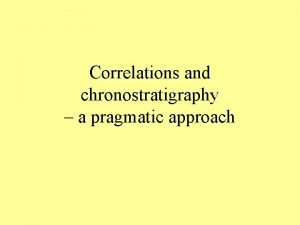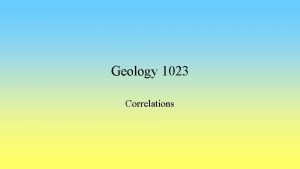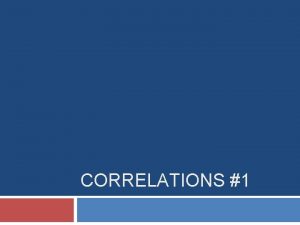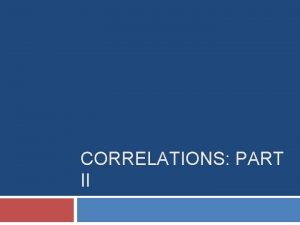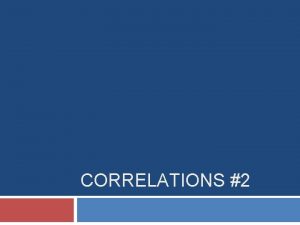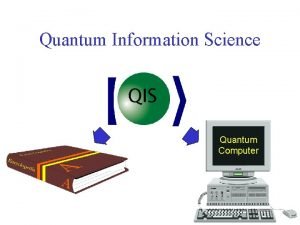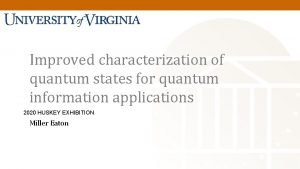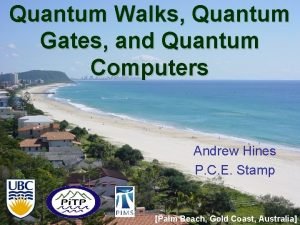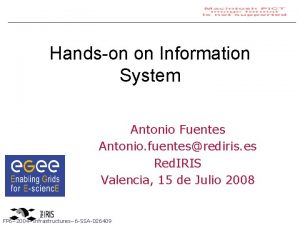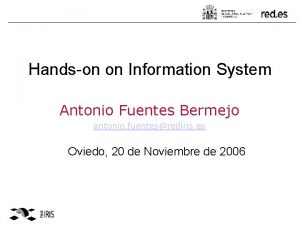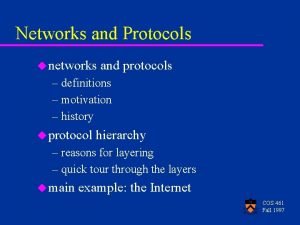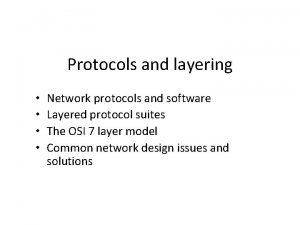Quantum correlations and deviceindependent quantum information protocols Antonio




























- Slides: 28

Quantum correlations and device-independent quantum information protocols Antonio Acín N. Brunner, N. Gisin, Ll. Masanes, S. Massar, M. Navascués, S. Pironio, V. Scarani Feynman Festival, Olomouc, June 2009

Scenario Distant parties performing m different measurements of r outcomes. Alice x=1, …, m y=1, …, m a=1, …, r b=1, …, r Bob Vector of m 2 r 2 positive components satisfying m 2 normalization conditions

Physical Correlations Physical principles translate into limits on correlations 1) Classical correlations: correlations established by classical means. These are the standard “EPR” correlations. Independently of fundamental issues, these are the correlations achievable by classical resources. Bell inequalities define the limits on these correlations. For a finite number of measurements and results, these correlations define a polytope, a convex set with a finite number of extreme points.

Physical Correlations 2) Quantum correlations: correlations established by quantum means. The set of quantum correlations is again convex, but not a polytope, even if the number of measurements and results is finite. 3) No-signalling correlations: correlations compatible with the nosignalling principle, i. e. the impossibility of instantaneous communication. The set of no-signalling correlations defines again a polytope.

Physical Correlations Bell Example: 2 inputs of 2 outputs CHSH inequality Trivial facets Popescu-Rohrlich BLMPPR

Motivation Is p(a, b|x, y) a quantum probability? Example: Are these correlations quantum? No constraint on the dimension → pure states and projective measurements

Motivation • What are the allowed correlations within our current description of Nature? • How can we detect the non-quantumness of some observed correlations? Quantum analogues of Bell inequalities. • What are the limits on correlations associated to the quantum formalism? • To which extent Quantum Mechanics is useful for information tasks? Previous work by Tsirelson and Wehner

Device-Independent Quantum Information protocols Goal: to construct information protocols where the parties can see their devices as quantum black-boxes → no assumption on the devices. Alice x=1, …, m y=1, …, m a=1, …, r b=1, …, r Bob

Outline of the talk • Introduction • Hierarchy of necessary conditions for quantum correlations • Definition of the hierarchy • Discussion of convergence • Device-Independent Quantum Information protocols • Quantum Key Distribution • Randomness Generation • Conclusions / Open questions

Hierarchy of necessary conditions Given a probability distribution p(a, b|x, y), we have defined a hierarchy consisting of a series of tests based on semi-definite programming techniques allowing the detection of supra-quantum correlations. YES NO Is the hierarchy complete? YES NO

Convergence of the hierarchy 1) If some correlations satisfy all the hierarchy, then: with ? 2) Rank loops: If n s. t. the distribution is quantum.

Device-Independent QKD Standard QKD protocols based their security on: 1. Quantum Mechanics: any eavesdropper, however powerful, must obey the laws of quantum physics. 2. No information leakage: no unwanted classical information must leak out of Alice's and Bob's laboratories. 3. Trusted Randomness: Alice and Bob have access to local random number generators. 4. Knowledge of the devices: Alice and Bob require some control (model) of the devices. Is there a protocol for secure QKD based on without requiring any assumption on the devices?

Security against collective attacks • Device-Independent protocol based on the CHSH Bell inequality. • Collective attacks: Eve prepares always the same state and measurements (identical and independent realizations). • Bound on Eve’s information as a function of the observed error and Bell inequality violation. The obtained critical QBER is of approx 7. 1%

Can the presence of randomness be guaranteed by any physical mechanism?

Randomness tests • Good randomness is usually verified by a series of statistical tests. • There exist chaotic systems, of deterministic nature, that pass all existing randomness tests. Uchida et al. , Nat. Phot. 2, 728 (2008) • Do these tests really certify the presence of randomness?

Known solutions • Classical Random Number Generators (CRNG): all of them are of deterministic Nature. • Quantum Random Number Generators (QRNG): all the existing solution require some knowledge of the devices. The provider has to be trusted. The standard solution crucially depends on the details of the device used for the random number generation. • In any case, all the solutions guarantee the randomness using standard statistical randomness tests.

Private Randomess • Many applications require private randomness. • Untrusted scenario: can one be sure that nobody has a deterministic model for the observed randomness? . . . Classical Memory …

Random Numbers from Bell’s Theorem • Randomness can be certified in the quantum world by means of non-local correlations, i. e. the violation of a Bell inequality. • The obtained randomness is private. • It represents a novel application of Quantum Information Theory, solving a task whose classical realization is, at least, unclear. • Our findings can be used to design Device. Independent Quantum Randomness Expanders.

Random Numbers from Bell’s Theorem We want to explore the relation between non-locality, measured by the violation β of a Bell inequality, and local randomness, quantified by. Clearly, if β =0 → r=1. x=1, 2 y=1, 2 a=+1, -1 b=+1, -1 NOTE: In all what follows, loopholes are not analyzed. They are important when considering the practical implementation of these ideas.

Results All the region above the curve is impossible within Quantum Mechanics.

Statement of the problem We have developed an asymptotically convergent series of sets approximating the quantum set.

Other Bell inequalities x=1, 2 a=1, …, r y=1, 2 b=1, …, r The same computation can be done for other inequalities, such as the CGLMP Bell inequality. One gets a perfectly random trit. The only known way of obtaining this point is by measuring a non-maximally entangled state. The more non-local → the more random

Randomness Witnesses The CHSH inequality at the maximal quantum violation defines a tangent to the quantum boundary. We consider other hyper-planes tangent to the quantum set. classical quantum The maximal quantum violation of any of these inequalities always guarantees perfect randomness. Arbitrarily small amounts of quantum non-locality give perfect randomness.

Device-Independent Quantum Randomness Expanders A device violating a Bell’s inequality can be used to generate random numbers. However, randomness is needed for the Bell test → Randomness Expander! Kent & Kollbeck In these devices, the two outcomes contain randomness and are useful. In the limit of very large α one gets two random bits. Quantum Theory is as random as possible. This is not the case for general no-signaling theories, where the number of random bits is at most one.

Quantum correlations • Hierarchy of necessary condition for detecting the quantum origin of correlations. • Each condition can be mapped into an SDP problem. • Is this hierarchy complete for tensor product measurements? • How does this picture change if we fix the dimension of the quantum system? • Are all finite correlations achievable measuring finite-dimensional quantum systems?

Random Numbers from Bell’s Theorem • Randomness can be certified in the quantum world by means of non-local correlations, i. e. the violation of a Bell inequality. • The obtained randomness is private. • It represents a novel application of Quantum Information Theory, solving a task whose classical realization is, at least, unclear. • Our findings can be used to design Device. Independent Quantum Randomness Expanders.

Take-home question (C or Q)RNG Specifications: it passes all statistical randomness tests. DIQRNE Specifications: It won’t pass all the existing randomness tests! Which device is more random?

r o f s k n a Th ! n o i t n e t t a r u o y Post-doc and Ph. D positions available in the group, see www. icfo. es
 Quantum correlations with no causal order
Quantum correlations with no causal order Mining frequent patterns associations and correlations
Mining frequent patterns associations and correlations Mining frequent patterns associations and correlations
Mining frequent patterns associations and correlations Mining frequent patterns associations and correlations
Mining frequent patterns associations and correlations Flag significant correlations
Flag significant correlations Spurious correlations
Spurious correlations Thinking critically
Thinking critically Classical mechanics
Classical mechanics Quantum physics vs quantum mechanics
Quantum physics vs quantum mechanics Proofs of work and bread pudding protocols
Proofs of work and bread pudding protocols Dedicated line
Dedicated line Cryptography standards and protocols
Cryptography standards and protocols Tcp and sctp are both layer protocols
Tcp and sctp are both layer protocols Network topologies and protocols
Network topologies and protocols Snmp uses tcp or udp
Snmp uses tcp or udp Lan standards and protocols
Lan standards and protocols Lab 4-1: routing concepts and protocols
Lab 4-1: routing concepts and protocols Data link layer protocols for noisy and noiseless channels
Data link layer protocols for noisy and noiseless channels Routing fabric
Routing fabric Routing and switching protocols
Routing and switching protocols Routing and switching protocols
Routing and switching protocols Plc norms and protocols
Plc norms and protocols Protocols and standards in computer networks
Protocols and standards in computer networks Chapter 3 network protocols and communications
Chapter 3 network protocols and communications Quantum information stephen barnett solutions
Quantum information stephen barnett solutions Type
Type Utopian simplex protocol
Utopian simplex protocol Channel partitioning mac protocols
Channel partitioning mac protocols Presentation layer protocols
Presentation layer protocols
